 W
WAdoration of the Christ Child was a 1431 or 1437 fresco by Paolo Uccello – some of the members of the family which commissioned it are shown. It was originally painted on a wall in the sacristy of San Martino church in Bologna, but it was later hacked off that wall, meaning that only two fragments survive. These are now on show in the first chapel on the left on the north aisle of the church's nave. On one of the fragments is a date starting 143, though it is unclear if the final digit is a 1 or a 7.
 W
WThe Prado Annunciation is an altarpiece painted by Giovanni da Fiesole, known now as Fra Angelico, in the 1420s. Originally intended for the Observant Dominican convent of Fiesole, the painting is currently in the collection of the Museo del Prado in Madrid.The work is one of three altarpieces by Fra Angelico representing the Annunciation; the other two being the Cortona Annunciation and the Annunciation of San Giovanni Valdarno. The sequence in which the three works were painted is not certain, but the general art historical consensus places the Prado version first.
 W
WAnnunciation is a panel painting by the German artist Stefan Lochner, the panels were probably conceived as outer wing for a lost altarpiece. It shows the virgin, rather conventionally receiving the voice of the holy spirit, who hovers above her in the form of a dove. A vase behind her holds a lily. Her white clothes and the flower represent her virginity. It seems influenced by similar panels found in Jan van Eyck's Ghent Altarpiece.
 W
WThe Annunciation is an oil on wood in grisaille painting by the Early Netherlandish artist Jan van Eyck, dated by art historians as between 1434 and 1436. The panels form a diptych, and are currently in the collection of the Museo Thyssen-Bornemisza, Madrid.
 W
WThe Annunciation of Cortona is a panel-painting altarpiece or retable by Fra Angelico: once housed in the Church of Gesù of Cortona, it is now held at the Museo Diocesano in Cortona.
 W
WThe Annunciation of San Giovanni Valdarno is a painting by Fra Angelico, painted in 1430 to 1432 in tempera on panel. It measures 195 cm by 158 cm. It was looted from Italy during the Second World War by the Germans and returned to the country via the work of Rodolfo Siviero. It is now held at the Museo della Basilica di Santa Maria delle Grazie in San Giovanni Valdarno.
 W
WThe Annunciation Triptych is an oil-on-panel triptych by the Netherlandish artist Rogier van der Weyden, dating from around 1434. It was originally formed by three panels, the central one being now at The Louvre museum in Paris, France; the side panels are at the Galleria Sabauda of Turin, northern Italy.
 W
WThe Berenson Madonna is a c.1432-1437 tempera and gold on panel painting by Domenico Veneziano, now in the Berenson collection at Villa I Tatti in Settignano. It was auctioned by the Panciatichi family and acquired by Berenson for his personal collection.
 W
WPrato Cathedral is a Roman Catholic cathedral in Prato, Tuscany, Central Italy, from 1954 the seat of the Bishop of Prato, having been previously, from 1653, a cathedral in the Diocese of Pistoia and Prato. It is dedicated to Saint Stephen, the first Christian martyr.
 W
WChrist on the Cross with the Virgin and Saint John is an oil on panel painting, later transferred to canvas, attributed to the Master of the Grimacing St John, a senior member of the workshop of Jan van Eyck. It was long attributed to Jan's brother Hubert, based on stylistic similarities to portions of the "Adoration of the lamb" passage in the Ghent Altarpiece. The Master of the Grimacing St John is one of only two assistant of van Eyck's whose hand can be identified across several works. He takes his notname from an imitation stone statue in a grisaille diptych wing panel of St. John the Baptist, opposite a Virgin and Child, and is associated with a pen and pencil drawing of St Paul in Vienna.
 W
WThe Coronation of the Virgin is a painting of the Coronation of the Virgin by the Italian early Renaissance master Fra Angelico, executed around 1434–1435. It is now in the Musée du Louvre of Paris, France. The artist executed another Coronation of the Virgin, now in the Uffizi in Florence.
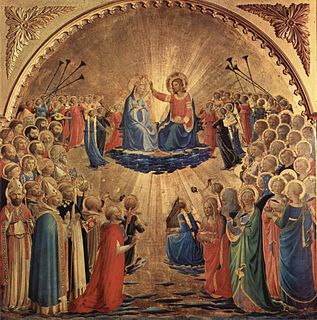 W
WThe Coronation of the Virgin is a painting of the Coronation of the Virgin by the Italian early Renaissance painter Fra Angelico, executed around 1432. It is now in the Uffizi Gallery of Florence. The artist executed another Coronation of the Virgin, now in the Louvre in Paris.
 W
WThe Cortona Triptych is a Catholic Church depiction of the Madonna and Child with saints, painted by Fra Angelico. It is now kept at the Diocesan Museum in Cortona, Italy. The painting dates from 1436–1437.
 W
WCrucifixion is a recently discovered early-15th-century drawing of the death of Jesus attributed to Jan van Eyck or his workshop, now in the collection of the Museum Boijmans van Beuningen. It is variously dated to the early 1430s, implying an original van Eyck, or c. 1440, making it a pastiche by a workshop member after Jan's death. The only other known van Eyck drawing is the Study for Cardinal Niccolò Albergati if you exclude the 1437 Saint Barbara as an unfinished painting, although there are similarities between the two; especially in its perspective, the angle of the observer's point of view, and the shadings of the rock formations. The quality of draftsmanship is of the first rate, and it is perhaps the most elaborate and complex surviving drawing from the 16th century.
 W
WThe Crucifixion and Last Judgement diptych consists of two small painted panels attributed to the Early Netherlandish artist Jan van Eyck, with areas finished by unidentified followers or members of his workshop. This diptych is one of the early Northern Renaissance oil on panel masterpieces, renowned for its unusually complex and highly detailed iconography, and for the technical skill evident in its completion. It was executed in a miniature format; the panels are just 56.5 cm (22.2 in) high by 19.7 cm (7.8 in) wide. The diptych was probably commissioned for private devotion.
 W
WThe Deposition from the Cross is a painting of the Deposition of Christ by the Italian Renaissance master Fra Angelico, executed between 1432 and 1434. It is now housed in the National Museum of San Marco, Florence.
 W
WThe Descent from the Cross is a panel painting by the Flemish artist Rogier van der Weyden created c. 1435, now in the Museo del Prado, Madrid. The crucified Christ is lowered from the cross, his lifeless body held by Joseph of Arimathea and Nicodemus.
 W
WDurán Madonna is an oil on oak panel painting completed sometime between 1435 and 1438 by the Netherlandish painter Rogier van der Weyden. The painting derives from Jan van Eyck's Ince Hall Madonna and was much imitated subsequently. Now in the Prado, Madrid, it depicts a seated and serene Virgin Mary dressed in a long, flowing red robe lined with gold-coloured thread. She cradles the child Jesus who sits on her lap, playfully leafing backwards through a holy book or manuscript on which both figures' gazes rest. But unlike van Eyck's earlier treatment, van der Weyden not only positions his Virgin and Child in a Gothic apse or niche as he had his two earlier madonnas, but also places them on a projecting plinth, thus further emphasising their sculptural impression.
 W
WThe Funerary Monument to Sir John Hawkwood is a fresco by Paolo Uccello, commemorating English condottiero John Hawkwood, commissioned in 1436 for Florence Cathedral. The fresco is an important example of art commemorating a soldier-for-hire who fought in the Italian peninsula and is a seminal work in the development of perspective.
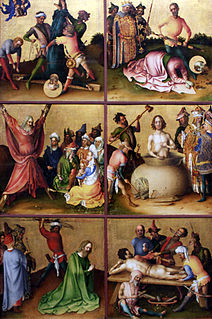 W
WLast Judgement is a c. 1435 tempera on oak polyptych by the German artist Stefan Lochner, probably commissioned for the council chamber of City Hall of Cologne, but now broken apart. Today the outer wings, which formed a sixfold partition when extended, have been sawed off into twelve individual pictures, most of which are still extant but held in separate collections, mostly in Cologne, Munich and Frankfurt. The interior wings included the Martyrdom of the Apostles, the exterior panels comprised in part of the Saint Anthony Abbot, Mary Magdalene and a Donor, Saints Catherine, Hubert, Quirinus of Neuss, and a Donor, and Pope Cornelius. Its depiction of the Last Judgment follows many of the conventions of contemporary doom paintings, but Lochner introduces important innovations, especially in his rendering of the angel's black and flowing clothes.
 W
WLéal Souvenir is a small oil-on-oak panel portrait by the Early Netherlandish painter Jan van Eyck, dated 1432. The sitter has not been identified, but his highly individual features suggest a historical person rather than the hypothetical ideal usual at the time in northern Renaissance portraiture; his slight and unassuming torso is contrasted with a sophisticated facial expression. His features have been described as "plain and rustic", yet thoughtful and inward-looking. A number of art historians, including Erwin Panofsky, have detected mournfulness in his expression. The sitter was apparently significant enough a member of the Burgundian duke Philip the Good's circle that his court painter portrayed him.
 W
WMadonna in the Church is a small oil panel by the early Netherlandish painter Jan van Eyck. Probably executed between c. 1438–40, it depicts the Virgin Mary holding the Child Jesus in a Gothic cathedral. Mary is presented as Queen of Heaven wearing a jewel-studded crown, cradling a playful child Christ who gazes at her and grips the neckline of her red dress in a manner that recalls the 13th-century Byzantine tradition of the Eleusa icon. Tracery in the arch at the rear of the nave contains wooden carvings depicting episodes from Mary's life, while a faux bois sculpture in a niche shows her holding the child in a similar pose. Erwin Panofsky sees the painting composed as if the main figures in the panel are intended to be the sculptures come to life. In a doorway to the right, two angels sing psalms from a hymn book. Like other Byzantine depictions of the Madonna, van Eyck depicts a monumental Mary, unrealistically large compared to her surroundings. The panel contains closely observed beams of light flooding through the cathedral's windows. It illuminates the interior before culminating in two pools on the floor. The light has symbolic significance, alluding simultaneously to Mary's virginal purity and God's ethereal presence.
 W
WThe Madonna of Chancellor Rolin is an oil painting by the Early Netherlandish master Jan van Eyck, dating from around 1435. It is kept in the Musée du Louvre, Paris, and was commissioned by Nicolas Rolin, aged 60, chancellor of the Duchy of Burgundy, whose votive portrait takes up the left side of the picture, for his parish church, Notre-Dame-du-Chastel in Autun, where it remained until the church burnt down in 1793. After a period in Autun Cathedral, it was moved to the Louvre in 1805.
 W
WThe Madonna of Humility is a painting by Fra Angelico which belongs to the Thyssen-Bornemisza Museum in Madrid and is conserved on loan at the National Art Museum of Catalonia.
 W
WThe Magdalen Reading is one of three surviving fragments of a large mid-15th-century oil-on-panel altarpiece by the Early Netherlandish painter Rogier van der Weyden. The panel, originally oak, was completed some time between 1435 and 1438 and has been in the National Gallery, London since 1860. It shows a woman with the pale skin, high cheek bones and oval eyelids typical of the idealised portraits of noble women of the period. She is identifiable as the Magdalen from the jar of ointment placed in the foreground, which is her traditional attribute in Christian art. She is presented as completely absorbed in her reading, a model of the contemplative life, repentant and absolved of past sins. In Catholic tradition the Magdalen was conflated with both Mary of Bethany who anointed the feet of Jesus with oil and the unnamed "sinner" of Luke 7:36–50. Iconography of the Magdalen commonly shows her with a book, in a moment of reflection, in tears, or with eyes averted.
 W
WThe Marriage of the Virgin is a painting by the Italian late medieval painter Michelino da Besozzo, dating from c. 1435 and housed in the Metropolitan Museum of Art of New York, USA.
 W
WNativity of the Virgin is a tempera on panel painting by the Master of the Osservanza Triptych, dated to around 1430-1435 and now in the Museo di palazzo Corboli in Asciano. It was inspired by Pietro Lorenzetti's 1335-1342 painting of the same scene. Its three lower panels show the Nativity of the Virgin, whilst the three upper panels show Death of the Virgin, Madonna of Humility and Burial of the Virgin.
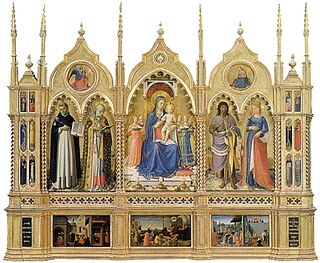 W
WThe Perugia Altarpiece is a painting by the Italian early Renaissance painter Fra Angelico, housed in the Galleria Nazionale dell'Umbria of Perugia, Italy.
 W
WPietà is a painting of 1430–1435 by Filippo Lippi in the Museo Horne, Florence.
 W
WPortrait of a Man with a Blue Chaperon is a very small oil on panel portrait of an unidentified man attributed to the Early Netherlandish painter Jan van Eyck.
 W
WPortrait of a Man with Carnation is a small oil on oakwood painting usually attributed to the Early Netherlandish master Jan van Eyck or a member of his workshop. Based on dendrochronological examination of the wood, it is thought to have been completed relatively late in van Eycks career, perhaps around 1436. It is now in the Gemäldegalerie, Berlin. The sitter wears a large grey fur lined hat, and grey clothes, fur lined at the neck. holds a small bunch of carnations, symbols of marriage. He has not been identified, but wears the medal of the Order of Saint Anthony, established by Albert I, Duke of Bavaria. The man is older, probably in his early 50s, and has a coarse, rough look, which the artist does not shy from depicting.
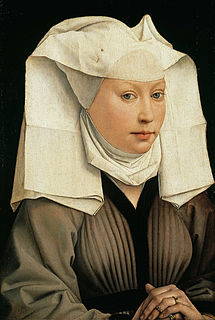 W
WPortrait of a Young Woman is a painting completed between 1435–1440 by the Netherlandish artist Rogier van der Weyden. The sitter in this small work wears a wide, white hennin over a brown dress, which features a black-lined, v-shaped neckline. As is usual of van der Weyden's female portraits, her hands are clasped tightly in prayer, while her expression is generally humble. Unusually for a van der Weyden', she does not bow her head or gaze into the middle distance. Instead she looks directly at the viewer, creating an intimate relationship between sitter, viewer and artist, which art historian and research curator Lorne Campbell describes as "appealing and vibrant".
 W
WPortrait of Baudouin de Lannoy is a small oil-on panel portrait by the Early Netherlandish painter Jan van Eyck, completed c. 1435. It shows Baldwin of Lannoy, a contemporary Flemish statesman and ambassador for Philip the Good at the court of Henry V of England. From surviving documents it is known that the work was commissioned to mark his entry into the order Baudouin de Lanno. He is in a formal pose, holding a wooden stick in his right hand, and a gold ring on his little finger. Van Eyck's surviving early portraits typically show the sitter holding an emblem of his profession and class.
 W
WThe Portrait of Cardinal Niccolò Albergati is a painting by early Netherlandish painter Jan van Eyck, dating to around 1431 and now in the Kunsthistorisches Museum of Vienna, Austria.
 W
WPortrait of Giovanni di Nicolao Arnolfini is a small c. 1438 portrait by Jan van Eyck believed to be the same person as in the famous 1434 Arnolfini Portrait due to the similarities of facial features. Thus, the work is van Eyck's second portrait of Giovanni di Nicolao Arnolfini, a wealthy merchant from Lucca, a city in Tuscany in central Italy, who spent most of his life in Flanders. The painting was long thought a self-portrait; in colourisation, costume and tone, it is very similar to the signed and dated Portrait of a Man in a Red Chaperon in London, which is generally accepted as a self-portrait. It was only later that the current work was associated with Arnolfini and the double marriage painting. It is today in the Gemäldegalerie, Berlin.
 W
WPortrait of Jan de Leeuw is a small 1436 oil on wood painting by the Early Netherlandish master Jan van Eyck, now in the Kunsthistorisches Museum, Vienna. De Leeuw was a goldsmith living in Bruges; most art historians accept that, given the familiarity of the portrait, that he and van Eyck knew each other and were on good terms. The work is still in its original frame, which is painted over to look like bronze.
 W
WPortrait of Margaret van Eyck is a 1439 oil on wood painting by the Early Netherlandish master Jan van Eyck. It is one of the two latest of his surviving paintings, and one of the earliest European artworks to depict a painter's spouse. Completed when she was around 34, it was hung until the early 18th century in the Bruges chapel of the Guild of painters. The work is thought to be a pendant or diptych panel for either a now lost self-portrait known from records until 1769, or of Jan van Eyck's likely self-portrait now in the National Gallery in London.
 W
WThe Portrait of Sigismund of Luxembourg is a tempera on panel painting formerly attributed to the Italian Late-Gothic master Pisanello and probably executed between 1432 and 1433. It is on display at the Kunsthistorisches Museum in Vienna, Austria.
 W
WSaint Anthony Abbot Tempted by a Heap of Gold is a painting by the 15th-century Sienese painter known as the Master of the Osservanza, now in the Metropolitan Museum of Art in New York. Completed circa 1435 in tempera and gold on panel, it is one of his cycle of eight works representing scenes from Saint Anthony's life.
 W
WSaint Barbara is a small 1437 drawing on oak panel, signed and dated 1437 by the Netherlandish artist Jan van Eyck. It is unknown if the work is a chalk ground study in pencil for a planned oil painting, an unfinished underdrawing or a completed work in of itself, although the latter is deemed more likely. The panel shows Saint Barbara imprisoned in a tower by her pagan father, to preserve her from the outside world, especially from suitors he did not approve of. While there, she converted to Christianity, enraging her father and leading to her murder and martyrdom.
 W
WSaint Christopher is a lost painting by Jan van Eyck. The painting is mainly recorded through a c 1460-70 copy on oil on oak panel, in the Philadelphia Museum of Art since 1917, and a c 1480 drawing at the Musee du Louvre. The c 1460-70 copy is by an unknown follower. Each show a giant, bearded man, wading through water with a large stick, carrying the infant Christ on his shoulders. The implication is that St. Christopher, patron saint of travelers, carries the weight of the world on his back; The works show him leaning on a large stick as Christ holds a globe, with arms raised in blessing, his robe billowing to the right. The pair are set in a highly detailed, richly coloured and atmospheric landscape. There are jagged rocks on either side, set against an early evening sky, with star formations.
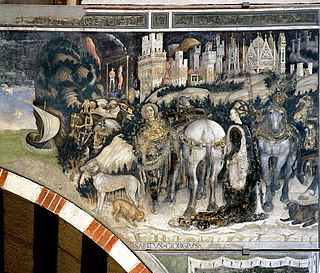 W
WSaint George and the Princess is a fresco by the Italian master Pisanello, located in the Pellegrini Chapel of the church of Sant'Anastasia, Verona, northern Italy. It is one of the most notable works of the International Gothic painting.
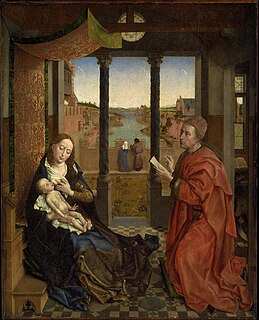 W
WSaint Luke Drawing the Virgin is a large oil and tempera on oak panel painting, usually dated between 1435 and 1440, attributed to the Early Netherlandish painter Rogier van der Weyden. Housed in the Museum of Fine Arts, Boston, it shows Luke the Evangelist, patron saint of artists, sketching the Virgin Mary as she nurses the Child Jesus. The figures are positioned in a bourgeois interior which leads out towards a courtyard, river, town and landscape. The enclosed garden, illusionistic carvings of Adam and Eve on the arms of Mary's throne, and attributes of St Luke are amongst the painting's many iconographic symbols.
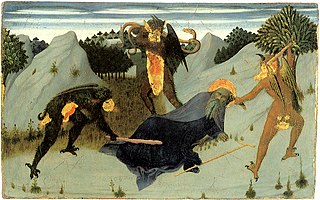 W
WSt. Anthony Beaten by Devils is a gothic style oil painting by Sassetta. It is a painted panel from a triptych he created called the Arte della Lana Altarpiece. It was commissioned by the Wool Merchants Guild for the Carmelites in Siena to use in their Feast of Corpus Domini.
 W
WThe St. Jerome in Penance is a painting by the Italian Renaissance painter Filippo Lippi, dating to c. 1439. It is housed in the Lindenau-Museum of Altenburg, Germany. The work could be identified with the St. Jerome Penitent of which Lippi asked payment in a letter issued to Piero de' Medici in 1439.
 W
WThe Tabernacle of the Linaioli is a marble aedicula designed by Lorenzo Ghiberti, with paintings by Fra Angelico, dating to 1432–1433. It is housed in the National Museum of San Marco, Florence, central Italy.
 W
WThe Triptych of the Madonna of Humility with saints is an altarpiece by Filippo Lippi, produced around 1430. It has been in the Fitzwilliam Museum in Cambridge since 1893. Its central panel shows the Madonna as the Madonna of humility. Its left panel shows John the Baptist, whilst its right panel shows Saint George or Saint Ansanus.
 W
WVera Icon is a lost oil-on panel portrait by the Early Netherlandish painter Jan van Eyck, which probably formed half of a since dismantled diptych. The original is known through three contemporary copies from his workshop. They were completed in 1438, 1439 and 1440; with the first and last in Bruges, and the 1439 version in Munich.
 W
WThe Virgin and Child Enthroned is a small oil-on-oak panel painting dated c. 1433, usually attributed to the Early Netherlandish artist Rogier van der Weyden. It is closely related to his Madonna Standing, completed during the same period. The panel is filled with Christian iconography, including representations of prophets, the Annunciation, Christ's infancy and resurrection, and Mary's Coronation. It is generally accepted as the earliest extant work by van der Weyden, one of three works attributed to him of the Virgin and Child enclosed in a niche on an exterior wall of a Gothic church. The panel is housed in the Museo Thyssen-Bornemisza in Madrid.
 W
WThe Virgin and Child with Canon van der Paele is a large oil-on-oak panel painting completed around 1434–1436 by the Early Netherlandish painter Jan van Eyck. It shows the painting's donor, Joris van der Paele, within an apparition of saints. The Virgin Mary is enthroned at the centre of the semicircular space, which most likely represents a church interior, with the Christ Child on her lap. St. Donatian stands to her right, Saint George—the donor's name saint—to her left. The panel was commissioned by van der Paele as an altarpiece. He was then a wealthy clergyman from Bruges, but elderly and gravely ill, and intended the work as his memorial.
 W
WVirgin and Child with Saints, is a large mid-15th century oil-on-oak altarpiece by the early Netherlandish painter Rogier van der Weyden. The work is lost since at least the 17th century, known only through three surviving fragments and drawing of the full work in Stockholm's Nationalmuseum by a follower of van der Weyden. The drawing is sometimes attributed to the Master of the Drapery Studies.